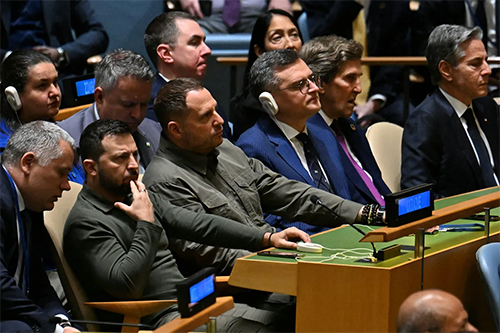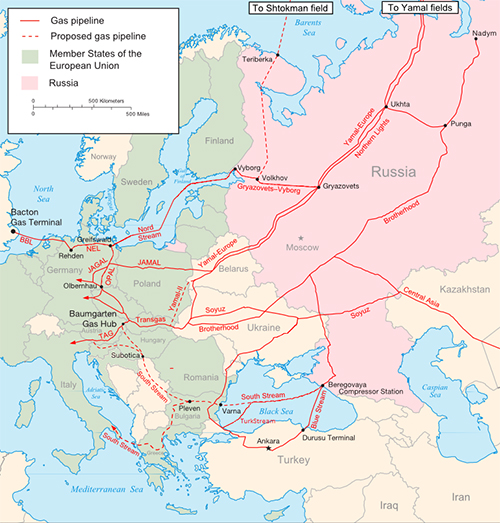by Seymour Hersh
September 13, 2023
NOTICE: THIS WORK MAY BE PROTECTED BY COPYRIGHT
YOU ARE REQUIRED TO READ THE COPYRIGHT NOTICE AT THIS LINK BEFORE YOU READ THE FOLLOWING WORK, THAT IS AVAILABLE SOLELY FOR PRIVATE STUDY, SCHOLARSHIP OR RESEARCH PURSUANT TO 17 U.S.C. SECTION 107 AND 108. IN THE EVENT THAT THE LIBRARY DETERMINES THAT UNLAWFUL COPYING OF THIS WORK HAS OCCURRED, THE LIBRARY HAS THE RIGHT TO BLOCK THE I.P. ADDRESS AT WHICH THE UNLAWFUL COPYING APPEARED TO HAVE OCCURRED. THANK YOU FOR RESPECTING THE RIGHTS OF COPYRIGHT OWNERS.
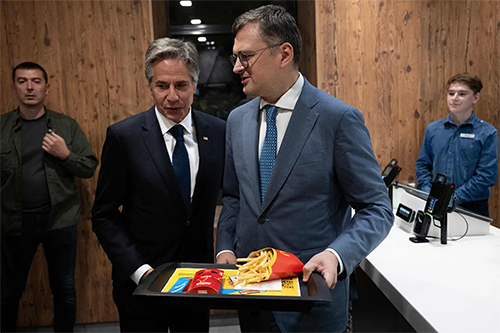
Secretary of State Antony Blinken and Ukraine’s Foreign Minister Dmytro Kuleba enjoy a happy meal last week in Kiev. / Photo by Brendan Smialowski / POOL / AFP.
On Sunday Secretary of State Antony Blinken told Jonathan Karl of ABC’s This Week that he remained “very confident in Ukraine’s ultimate success” in the ongoing war with Russia. He depicted Ukraine President Volodymyr Zelensky’s decision to escalate its attacks inside Russia as “their decision, not ours.”
Blinken’s wrong-headed confidence and his acceptance of a significant escalation in the Ukraine war defies belief, given the reality on the ground today in the war. But it also could be based on insanely optimistic assessments supplied by the Defense Intelligence Agency. The DIA’s assessments, as I have reported, are now the intelligence of choice inside the White House.
As a journalist who has written about national security matters for many decades, how can I explain a process that is clearly contrary to the best interests of the people of the United States and its leadership?
One answer is that it is now an accepted reality that presidents in the post-9/11 era do not hesitate to manipulate and lie about even the most competent of intelligence reports if they do not fit into their political agenda. What began in the Bush/Cheney years—remember the lying about weapons of mass destruction in Iraq—continued during the presidency of the much beloved, much misunderstood Barack Obama. Ten years ago, amid calls for the US to intervene in the Syrian civil war against the reviled Bashar al-Assad, the White House did not receive crucial intelligence because it was politically inconvenient. The case involved a five page all-source report prepared for the Defense Intelligence Agency about a strategic weapon—the nerve gas sarin—that was known to be in the hands of the Islamist opposition to the Syrian government led by Assad. The detailed report, which included vital information gleaned from intercepts by the National Security Agency, did not reach the White House because—so I came to understand—it revealed the kind of truth that presidents then and now viewed as political poison. Passing such information would also raise questions about the political savvy and dependability of those running the agency involved. Intelligence to please in these days of quick fixes and double talk always trumps intelligence that raises difficult questions.
I cited a few lines from the DIA study in a report I wrote at the time for the London Review of Books about the 2013 sarin attack in Syria, but I chose to limit my reporting in order to protect the ability of the NSA to penetrate the most secret doings of America’s Islamist enemies. The document, with my handwritten notes, is posted at the bottom of this report. I am doing this because what happened then is happening today inside the American intelligence community and, if not curtailed, could lead the short-sighted White House into an expanded war with Russia that no one wants.
The issue began in 2013 when there were allegations of Syrian use of chemical weapons in its war against a merged group of Jihadist forces, known as al-Nusra, whose goal was to overthrow the Baathist Assad government and establish an Islamic state in Syria. Al-Nusra had been designated by the State Department late in 2012 as a “foreign terrorist organization” and identified as an affiliate of Al Qaeda.
There were some in the Obama administration who cynically argued that al-Nusra should be aided in its war against the Assad government, and dealt with after Assad’s ouster. The most complete history of the administration’s concern about the Syrian chemical warfare arsenal can be found in The World As It Is, the 2018 memoir by Ben Rhodes, one of Obama’s national security advisers. (The first volume of Obama’s memoirs of his years in the White House, A Promised Land, published in 2020, ended with the end of his first term in office in early 2013.)
In Rhodes’s account, Syria’s possession and potential use of sarin had been an issue in Washington for a year before the Syrian government was accused in late August of 2013 of carrying out a nerve gas attack on Ghouta, a suburb of Damascus, the Syrian capital, killing as many as 1,500, according to the initial reports. There also was a fear that the Assad government would provide sarin to Hezbollah, the Shiite militia in Lebanon backed by Iran and avowed enemy of Israel. In August 2012 Obama publicly stated that “We have been very clear to the Assad regime . . . that a red line for us is we start seeing a whole bunch of chemical weapons moving around or being utilized. That would change my calculus.”
While on vacation in August 2013, Rhodes learned there was a “high confidence assessment” that a nerve agent had killed more than a thousand people and that “the Assad regime was responsible.” At this point, Rhodes writes, “One after another, officials advised Obama to order a military strike.”
All of this was being conveyed to the American press and public by the administration. Rhodes writes: “I started to plan a public campaign to ramp up to a military intervention. John Kerry could make a statement . . . making the case for action. The intelligence community would have to make its assessment public. It felt energizing, as though we were finally going to do something to shape events in Syria.”
Rhodes does not report that over the next few weeks doubts about who did what in Syria were being conveyed directly to Obama. General Martin Dempsey, chairman of the Joint Chief of Staff, who Rhodes says had initially supported an immediate military response, changed his mind and, I was told by a senior intelligence official, warned the president that the nerve used in the attack did not match that known to exist in the Syrian army arsenal. And as Obama himself told a journalist before leaving office, he was advised by Director of National Intelligence James Clapper that the case that the Assad regime carried out the gas attack was not a “slam dunk.” Obama eventually canceled plans for a major strike on military and industrial sites throughout Syria.
Rhodes clearly had not been told anything about the DIA’s two-month-old all-source intelligence assessment, which included some specific data from the National Security Agency, making clear that there were two possible suspects for any nerve gas attack—Syria and al-Nusra. The document emphasizes the threat of al-Nusra’s chemical arsenal. The opening sentences reek of urgency:
“The al-Nusrah Front associated sarin production cell is the most advanced sarin plot since al-Qaida’s pre 9/11 effort. Arrests in Iraq and Turkey have disrupted the cell’s operations; however we assess the intent to produce advanced chemical weapon (CW) remains. Previous IC [intelligence community] focus had been almost entirely on Syrian CW stockpiles; now we see ANF [al-Nusra Front] attempting to make its own CW. In this brief we will discuss the network, its capabilities, and future indications of CW related activity.”
The DIA analysis, captioned as Talking Points, goes on to warn that al-Nusra’s “relative freedom of operations within Syria leads us to assess the group’s CW aspirations will be difficult to disrupt in the future.” One factor contributing to its freedom of operation was that America and its allies were not targeting it.
The five-page document—I deleted its classified markings—was described as a “Brief to DD Shedd” and dated 20 June. It depicted al Nusra chemical warfare actions up to that date. “Shedd” referred to David Shedd, a longtime CIA official who was named deputy director of the DIA by Obama in 2010 and served there until 2015, with the last year as acting director.
The copy I obtained of the Talking Points did not originate in the Pentagon or in Washington, but was considered to be important enough to have been distributed in secret to highly classified black sites and similar units outside of Washington. There is no evidence that the analysis or the information it contained reached the White House or Ben Rhodes himself, despite the role Obama assigned him to manage the response to the attack in Ghouta.
At the time I obtained the document, I was reporting on the attack and the US response for the London Review of Books. I learned then from a senior DIA official that such a document existed but cited only a few lines of the five-page paper largely because I worried about compromising the source of what obviously was excellent intelligence work. I wrote at the time that General Dempsey had directly warned Obama that the nerve agent used in the attack did not match equally lethal materials known to be in the Syrian chemical warfare arsenal. The Syrian CW installations—which at one time totaled 26 separate depots—had been closely monitored for two decades by a joint collection program run by US and Israeli intelligence.
So the question remains: why did the DIA intelligence not get to the White House? I put that to a senior intelligence official, after sharing the paper with him. His answer was that it was an obvious hot potato that was ignored “for political expediency”—just as much of the CIA’s current reporting on the failed Ukraine offensive has been ignored by Blinken and other foreign policy officials in the Biden administration.
The intelligence official said the designation of the document as “Talking Points” meant that it was “never intended for the president, but only to alert the DIA that there was hard evidence beginning to appear from a multitude of sources that there was another explanation of sarin use which should balance any accusation of Assad. Like any good summary it is: ‘Wait and see. It is a complex issue.’”
He said that the document was “credible because it is all-source and balanced. It draws no conclusions—just cautions” that the issue cannot be packaged in a final assessment because many of the known al-Nusra players involved in the production of nerve gas were still under surveillance. Thus, he said, only an overview was in order.
My reporting at the time made the point that there were two possible suspects for the sarin attack but only one publicly cited by White House. I spent many hours going back and forth with a White House press aide trying to get a response about the material I had. I was initially told that the Obama White House would not comment on the record about my report. I persisted and provided more specifics to the aide and eventually received a note, unilaterally designated as “Off the Record” (to make comments “off the record” requires both sides to agree to it), that said: “[N]o one is saying the memo is not a physical thing that exists. What we are saying is that it is not an official memo and the facts that you alleged that it contains are almost 100 per cent incorrect—which is probably why almost no one has seen it. It likely did not go forward because it was wrong.” A later note from the spokesperson, also marked “off the record,” added that the memo “is not something that his [Shedd’s] office received. Since neither the WH [White House] nor the DNI [director of national intelligence Clapper] have seen the alleged memo…it’s unclear whether it’s a fake or a draft that was never sent forward because it contained information that was incorrect.”
This kind of dissembling did not begin with the Biden Administration.
The Shedd Memo
Below is the full text of the five-page DIA assessment of al-Nusra’s chemical warfare capability from June 20, 2013. The markings on the pages are mine and mostly aimed at spelling out acronyms and unit names. It is a superior piece of analysis.
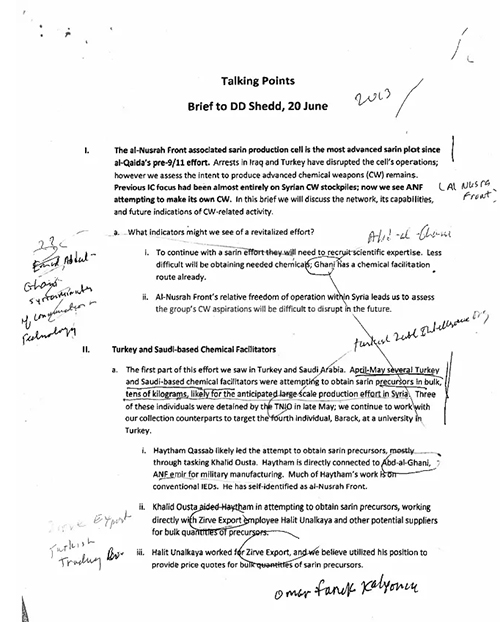
Page 1
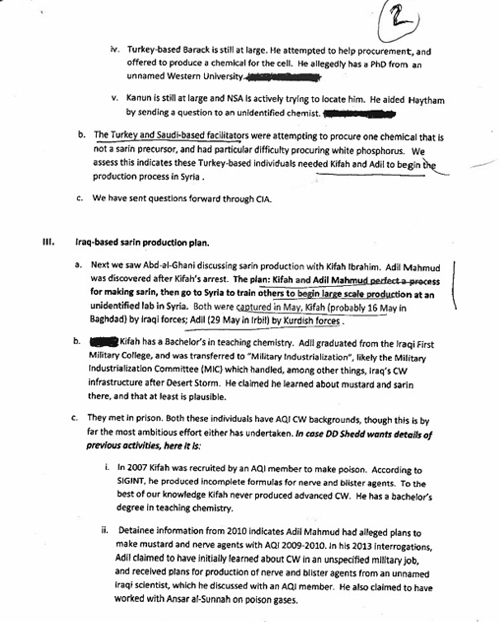
Page 2
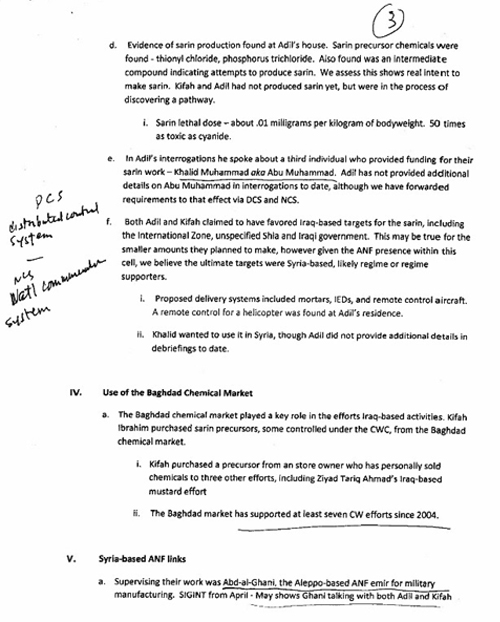
Page 3
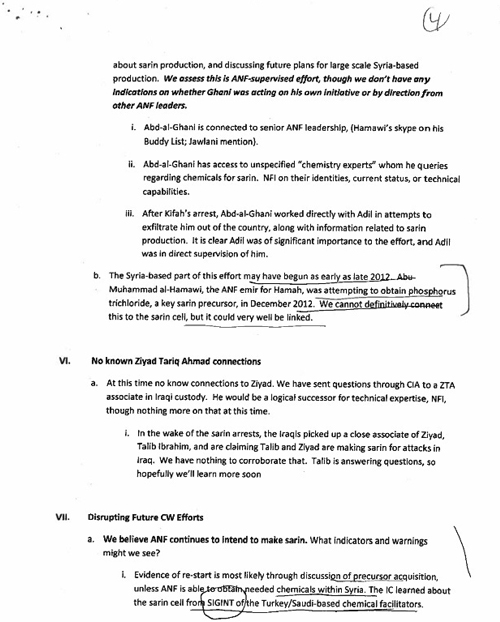
Page 4
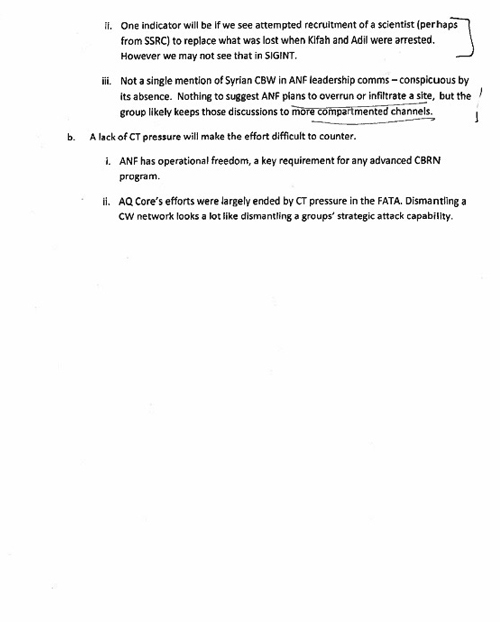
Page 5

